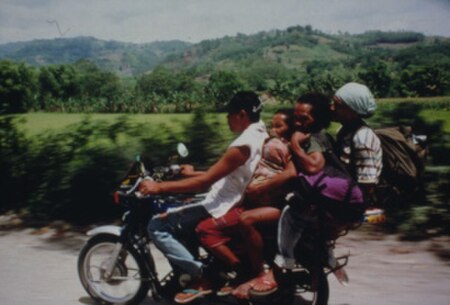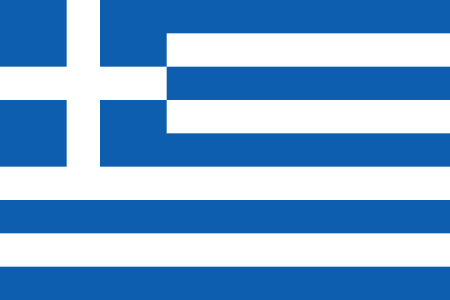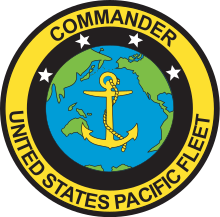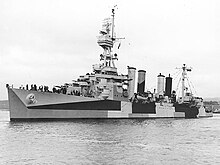United States Pacific Fleet
| |||||||||||||||||||||||||||||||
Read other articles:

Philippine indigenous people For the language, see Cotabato Manobo language. This article needs additional citations for verification. Please help improve this article by adding citations to reliable sources. Unsourced material may be challenged and removed.Find sources: Tasaday – news · newspapers · books · scholar · JSTOR (September 2021) (Learn how and when to remove this message) TasadayThe Tasaday people in their homeland, the last primal rainforest …

Teras travertin di Mammoth Hot Springs, Taman Nasional Yellowstone Travertin adalah bentuk batu kapur yang didepositkan oleh mata air mineral, terutama air panas. Travertin sering memiliki penampilan berserat atau konsentris dan ada yang berwarna putih, cokelat dan varietas berwarna krem. Hal ini dibentuk oleh suatu proses pengendapan cepat kalsium karbonat, sering di mulut sumber air panas atau di gua kapur. Pada keduanya dapat membentuk stalaktit, stalagmit dan speleothem lainnya. Batu ini ser…

Filipino lawyer, civil organizer, and human-rights activist (1964–2021) In this Philippine name, the middle name or maternal family name is Cosgayon and the surname or paternal family name is Gascon. Chito Gascon7th Chairman of the Commission on Human RightsIn officeJune 18, 2015 – October 9, 2021PresidentBenigno Aquino III Rodrigo DutertePreceded byLoreta Ann P. RosalesSucceeded byLeah Tanodra-ArmamentoMember of the Philippine House of Representatives for YouthIn officeJun…

This article relies excessively on references to primary sources. Please improve this article by adding secondary or tertiary sources. Find sources: Estill Voice Training – news · newspapers · books · scholar · JSTOR (June 2021) (Learn how and when to remove this message) Estill Voice TrainingAbbreviationEVTFormation1988; 36 years ago (1988)FounderJo EstillHeadquartersPittsburgh, PennsylvaniaPresidentDr. Kimberly SteinhauerParent organiz…

2016年美國總統選舉 ← 2012 2016年11月8日 2020 → 538個選舉人團席位獲勝需270票民意調查投票率55.7%[1][2] ▲ 0.8 % 获提名人 唐納·川普 希拉莉·克林頓 政党 共和黨 民主党 家鄉州 紐約州 紐約州 竞选搭档 迈克·彭斯 蒂姆·凱恩 选举人票 304[3][4][註 1] 227[5] 胜出州/省 30 + 緬-2 20 + DC 民選得票 62,984,828[6] 65,853,514[6] 得…

Pour les articles homonymes, voir Klein. Mathieu Klein Mathieu Klein en 2019. Fonctions Président de la Métropole du Grand Nancy En fonction depuis le 17 juillet 2020(3 ans, 9 mois et 27 jours) Élection 17 juillet 2020 Prédécesseur André Rossinot Maire de Nancy En fonction depuis le 5 juillet 2020(3 ans, 10 mois et 9 jours) Élection 5 juillet 2020 Coalition PS-PCF-EÉLV-G·s-NE Prédécesseur Laurent Hénart Conseiller départementalde Meurthe-et-Moselle 2 av…

Timbaland Timbaland pendant le Shock Value II Tour en janvier 2010.Informations générales Surnom Timbo Nom de naissance Timothy Zachery Mosley Naissance 10 mars 1972 (52 ans)Norfolk, Virginie (États-Unis) Activité principale Rappeur, chanteur, producteur, disc jockey Genre musical Hip-hop, pop-rap, RnB, pop rock Instruments Voix, percussions, sampleur, Platines, Sequenceur Années actives Depuis 1990 Labels Blackground, Mosley Music Group, Interscope, Roc Nation modifier Timbaland (pron…

Criminal incidents involving the Bandidos Motorcycle Club in Denmark Main article: Bandidos MC criminal allegations and incidents A Bandidos member in Denmark. The Bandidos Motorcycle Club is classified as a motorcycle gang by law enforcement and intelligence agencies in numerous countries. While the club has denied being a criminal organization, Bandidos members have been convicted of partaking in criminal enterprises including theft, extortion, prostitution, drug trafficking and murder in vari…

Form of network filtering Deep content inspection (DCI) is a form of network filtering that examines an entire file or MIME object as it passes an inspection point, searching for viruses, spam, data loss, key words or other content level criteria. Deep Content Inspection is considered the evolution of Deep Packet Inspection with the ability to look at what the actual content contains instead of focusing on individual or multiple packets. Deep Content Inspection allows services to keep track of c…

BobbyInformasi latar belakangNama lahirKim Ji-wonNama lainBobbyLahir21 Desember 1995 (umur 28)Seoul, Korea SelatanAsalLahir di Seoul, Korea Selatan dan dibesarkan di Virginia, Amerika SerikatGenreK-pop, hip hopPekerjaanRapperTahun aktif2013-kiniLabel YG Entertainment (2015-2022) 143 Entertainment (2023-sekarang) Artis terkaitTim B, iKONSitus webwww.ygfamily.com Nama KoreaHangul김지원 Alih AksaraGim Ji-wonMcCune–ReischauerKim Chi-wŏn Kim Ji-won (Hangul: 김지원) atau yang le…

Filipino painter and sculptor Abdulmari Asia ImaoBorn(1936-01-14)14 January 1936Siasi, Sulu, Philippine CommonwealthDied16 December 2014(2014-12-16) (aged 78)Marikina, PhilippinesNationalityFilipinoEducationUniversity of the Philippines University of KansasKnown forSculpture, PaintingAwards Order of National Artists of the Philippines Abdulmari Asia Imao (January 14, 1936 – December 16, 2014) was a Filipino painter and sculptor. Imao was named National Artist of the Philippines for V…

1954 film by David Lean Hobson's ChoiceTheatrical release posterDirected byDavid LeanWritten byHarold Brighouse (play)Wynyard BrowneDavid LeanNorman SpencerProduced byDavid LeanAlexander KordaStarringCharles LaughtonJohn MillsBrenda de BanzieDaphne AndersonPrunella ScalesCinematographyJack HildyardEdited byPeter TaylorMusic byMalcolm ArnoldProductioncompanyLondon FilmsDistributed byBritish Lion FilmsUnited ArtistsRelease date 19 April 1954 (1954-04-19) Running time107 minutesCount…

Amusement park ride A typical motion ride simulator mounted on a trailer to make it mobile. Simulator rides are a type of amusement park or fairground ride, where the audience is shown a movie while their seats move to correspond to the action on screen. There are many types but they fall into the heading of entertainment unlike the ones used for training. Simulator rides work by showing a film and moving at the same time. This information is fixed and cannot be changed without rewriting the rid…

Weekly news magazine published in Belgrade, Serbia NINНИНEditor-in-chiefAleksandar TimofejevCategoriesNewsmagazineFrequencyWeeklyPublisherPolitika a.d. (1958–2007)Ringier Axel Springer d.o.o. (2009–2023)Jelena Drakulić Petrović (2023-)First issue26 January 19357 January 1951(re-established)CountrySerbiaLanguageSerbianWebsitewww.nin.co.rs NIN (Serbian Cyrillic: НИН) is a weekly news magazine published in Belgrade, Serbia. Its name is an acronym for Nedeljne informativne novine (Нед…

English priest and scholar (1858–1933) An erudite DeanAs depicted by Spy (Leslie Ward) in Vanity Fair, December 1905 Memorial in Wells Cathedral Joseph Armitage Robinson KCVO FBA (9 January 1858 – 7 May 1933) was a priest in the Church of England and scholar. He was successively Dean of Westminster (1902–1911) and of Wells (1911–1933). Biography Robinson was born the son of a poor vicar in Keynsham, and was educated at Liverpool College and Christ's College, Cambridge, of which he be…

Celebration of a girl's 15th birthday For other uses, see Quinceañera (disambiguation). This article needs additional citations for verification. Please help improve this article by adding citations to reliable sources. Unsourced material may be challenged and removed.Find sources: Quinceañera – news · newspapers · books · scholar · JSTOR (May 2020) (Learn how and when to remove this message) Mexican American girls at a quinceañera celebration in Santa…

American playwright and director David AuburnBorn (1969-11-30) November 30, 1969 (age 54)Chicago, Illinois, U.S.OccupationPlaywright, screenwriter, theatre directorEducationUniversity of Chicago (BA)Juilliard School (GrDip)Children2 David Auburn (born 30 November 1969)[1] is an American playwright, screenwriter and theatre director. He is best known for his 2000 play Proof, which won the 2001 Tony Award for Best Play and Pulitzer Prize for Drama. He also wrote the screenplays for th…

CarrobbioIl Carrobbio nel 2009LocalizzazioneStato Italia CittàMilano Codice postaleI-20123 Informazioni generaliTipopiazza Intitolazionedal latino quadruvium (incrocio di quattro vie) CollegamentiTrasportiLinee di bus, tranviarie e metropolitana leggera Mappa Modifica dati su Wikidata · Manuale Il Carrobbio (el Carròbi in dialetto milanese), indicato anche col termine oggi desueto di Corrivio, è un largo di Milano le cui origini risalgono all'epoca romana. È posto indicativamente …

سيساميا تقسيم إداري البلد اليونان [1] إحداثيات 40°57′29″N 23°25′29″E / 40.958055555556°N 23.424722222222°E / 40.958055555556; 23.424722222222 السكان التعداد السكاني 330 (resident population of Greece) (2021)493 (resident population of Greece) (2001)487 (resident population of Greece) (1991)329 (resident population of Greece) (2011) الرمز الجغرافي 734270 تع�…

Artikel ini perlu diwikifikasi agar memenuhi standar kualitas Wikipedia. Anda dapat memberikan bantuan berupa penambahan pranala dalam, atau dengan merapikan tata letak dari artikel ini. Untuk keterangan lebih lanjut, klik [tampil] di bagian kanan. Mengganti markah HTML dengan markah wiki bila dimungkinkan. Tambahkan pranala wiki. Bila dirasa perlu, buatlah pautan ke artikel wiki lainnya dengan cara menambahkan [[ dan ]] pada kata yang bersangkutan (lihat WP:LINK untuk keterangan lebih lanjut). …




